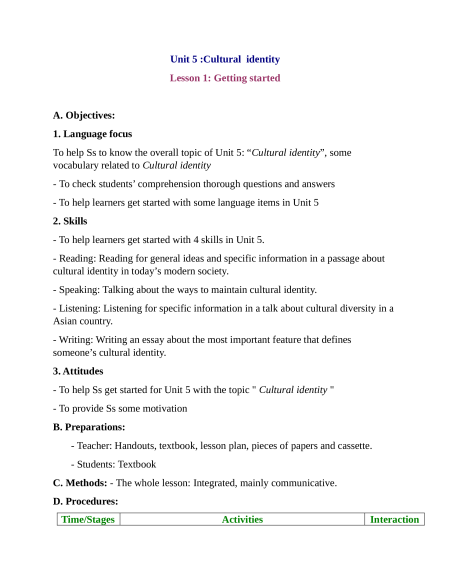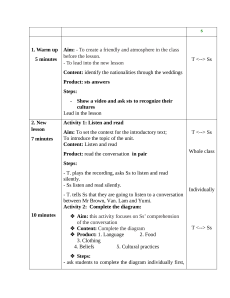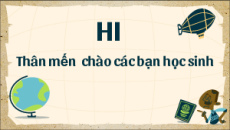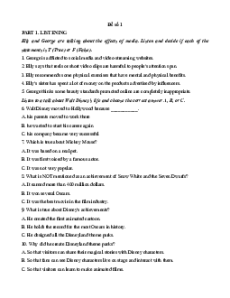Unit 5 :Cultural identity
Lesson 1: Getting started A. Objectives: 1. Language focus
To help Ss to know the overall topic of Unit 5: “Cultural identity”, some
vocabulary related to Cultural identity
- To check students’ comprehension thorough questions and answers
- To help learners get started with some language items in Unit 5 2. Skills
- To help learners get started with 4 skills in Unit 5.
- Reading: Reading for general ideas and specific information in a passage about
cultural identity in today’s modern society.
- Speaking: Talking about the ways to maintain cultural identity.
- Listening: Listening for specific information in a talk about cultural diversity in a Asian country.
- Writing: Writing an essay about the most important feature that defines someone’s cultural identity. 3. Attitudes
- To help Ss get started for Unit 5 with the topic " Cultural identity "
- To provide Ss some motivation B. Preparations:
- Teacher: Handouts, textbook, lesson plan, pieces of papers and cassette. - Students: Textbook
C. Methods: - The whole lesson: Integrated, mainly communicative. D. Procedures: Time/Stages Activities Interaction s
1. Warm up Aim: - To create a friendly and atmosphere in the class before the lesson. 5 minutes T <--> Ss - To lead into the new lesson
Content: identify the nationalities through the weddings Product: sts answers Steps:
- Show a video and ask sts to recognize their cultures Lead in the lesson 2. New
Activity 1: Listen and read lesson
Aim: To set the context for the introductory text; T <--> Ss 7 minutes
To introduce the topic of the unit.
Content: Listen and read
Product: read the conversation in pair Whole class Steps:
- T. plays the recording, asks Ss to listen and read silently. - Ss listen and read silently. Individually
- T. tells Ss that they are going to listen to a conversation
between Mr Brown, Van. Lam and Yumi.
Activity 2: Complete the diagram: 10 minutes
Aim: this activity focuses on Ss’ comprehension of the conversation
Content: Complete the diagram T <--> Ss
Product: 1. Language 2. Food 3. Clothing
4. Beliefs 5. Cultural practices Steps:
- ask students to complete the diagram individually first,
and then compare their answers with a partner.
- call on sts to give answers
-check their answers and give feedback
Activity 3: Answer the following questions
Aim: this activity focuses on Ss’ comprehension Individually of the conversation
Content: Answer the following questions or Product: Pair work
1. Because it’s essential to understand their family history and traditions.
2. They wear kimonos on special occasions and celebrate
Japanese festivals. They eat sushi, sashimi and udon
noodles. They also speak Japanese at home. 10 minutes
3. She doesn’t know whether her home is Japan, where T <--> Ss
her parents come from, or Viet Nam, where she was born and grew up.
4. (Suggested answer): Language: Vietnamese; food:
square and round sticky rice cakes, pho; clothing: ao dai,
ao ba ba; beliefs: ancestor worship; cultural practices:
Hung Kings’ Festival, Quan ho singing Steps:
- T. asks Ss to read the questions, and underline any key
words before they scan the conversation for the answers. - move around to provide helps 10 minutes - call on sts to give answers - check and give feedback
Activity 4: Find the verb or adjective that goes with Individually
each of the following nouns or noun phrases. If
necessary, use a dictionary to check the meaning.
Aim: This activity focuses on the collocations used in the conversation
Content: Find the verb or adjective that goes with each
of the following nouns or noun phrases. If necessary, use
a dictionary to check the meaning.
Product: 1. express/ protect 2. traditional T <--> Ss 3. cultural 4. understand 5. maintain Steps:
- T asks students to read the conversation again and find
the verbs or adjectives that go with the given nouns or noun phrases. - call on sts to give answers - Check and give feedback
Activity 5: Read the conversation again and write the
correct tenses of the verbs in brackets.
Aim: This activity focuses on revision of the present
perfect and the present perfect continuous tense.
Content: Read the conversation again and write the
correct tenses of the verbs in brackets.
Product: 1.have been living/ have lived 2. ’ve been Steps:
- T asks students to write the correct tenses of the verbs
in brackets first, and then has them read the
conversation to check their answers. 3.
- Ask Ss: What have you learnt today? What can you do now? Consolidati T <--> Ss on
- Summarize the main points of the lesson. 2 minutes 4.
- Ask Ss to learn by heart the words or phrases related to Homework the topic
Giáo án Unit 5: Cultural identity Tiếng Anh 12 (mới CV 5512)
617
309 lượt tải
MUA NGAY ĐỂ XEM TOÀN BỘ TÀI LIỆU
CÁCH MUA:
- B1: Gửi phí vào TK:
1133836868- CT TNHH DAU TU VA DV GD VIETJACK - Ngân hàng MB (QR) - B2: Nhắn tin tới Zalo VietJack Official ( nhấn vào đây ) để xác nhận thanh toán và tải tài liệu - giáo án
Liên hệ ngay Hotline hỗ trợ: 084 283 45 85
Bộ giáo án Tiếng Anh 9 (mới CV5512) được cập nhật liên tục trong gói này từ nay đến hết tháng 3/2024.
Để tải tài liệu gốc về máy bạn click vào nút Tải Xuống ở trên!
Thuộc bộ (mua theo bộ để tiết kiệm hơn):
- Bộ giáo án Tiếng Anh 12 mới CV 5512 chuẩn nhất được thiết kế theo phong cách hiện đại, đẹp mắt, trình bày chi tiết cho từng bài học và bám sát chương trình Sách giáo khoa Tiếng Anh 12.
- Mua trọn bộ sẽ tiết kiệm hơn tải lẻ 50%.
Đánh giá
4.6 / 5(617 )5
4
3
2
1
Trọng Bình
Tài liệu hay
Giúp ích cho tôi rất nhiều
Duy Trần
Tài liệu chuẩn
Rất thích tài liệu bên VJ soạn (bám sát chương trình dạy)
TÀI LIỆU BỘ BÁN CHẠY MÔN Tiếng Anh
Xem thêmTÀI LIỆU BỘ BÁN CHẠY Lớp 12
Xem thêmTài liệu bộ mới nhất

Unit 5 :Cultural identity
Lesson 1: Getting started
A. Objectives:
1. Language focus
To help Ss to know the overall topic of Unit 5: “Cultural identity”, some
vocabulary related to Cultural identity
- To check students’ comprehension thorough questions and answers
- To help learners get started with some language items in Unit 5
2. Skills
- To help learners get started with 4 skills in Unit 5.
- Reading: Reading for general ideas and specific information in a passage about
cultural identity in today’s modern society.
- Speaking: Talking about the ways to maintain cultural identity.
- Listening: Listening for specific information in a talk about cultural diversity in a
Asian country.
- Writing: Writing an essay about the most important feature that defines
someone’s cultural identity.
3. Attitudes
- To help Ss get started for Unit 5 with the topic " Cultural identity "
- To provide Ss some motivation
B. Preparations:
- Teacher: Handouts, textbook, lesson plan, pieces of papers and cassette.
- Students: Textbook
C. Methods: - The whole lesson: Integrated, mainly communicative.
D. Procedures:
Time/Stages Activities Interaction

s
1. Warm up
5 minutes
Aim: - To create a friendly and atmosphere in the class
before the lesson.
- To lead into the new lesson
Content: identify the nationalities through the weddings
Product: sts answers
Steps:
- Show a video and ask sts to recognize their
cultures
Lead in the lesson
T <--> Ss
2. New
lesson
7 minutes
10 minutes
Activity 1: Listen and read
Aim: To set the context for the introductory text;
To introduce the topic of the unit.
Content: Listen and read
Product: read the conversation in pair
Steps:
- T. plays the recording, asks Ss to listen and read
silently.
- Ss listen and read silently.
- T. tells Ss that they are going to listen to a conversation
between Mr Brown, Van. Lam and Yumi.
Activity 2: Complete the diagram:
Aim: this activity focuses on Ss’ comprehension
of the conversation
Content: Complete the diagram
Product: 1. Language 2. Food
3. Clothing
4. Beliefs 5. Cultural practices
Steps:
- ask students to complete the diagram individually first,
T <--> Ss
Whole class
Individually
T <--> Ss

10 minutes
10 minutes
and then compare their answers with a partner.
- call on sts to give answers
-check their answers and give feedback
Activity 3: Answer the following questions
Aim: this activity focuses on Ss’ comprehension
of the conversation
Content: Answer the following questions
Product:
1. Because it’s essential to understand their family
history and traditions.
2. They wear kimonos on special occasions and celebrate
Japanese festivals. They eat sushi, sashimi and udon
noodles. They also speak Japanese at home.
3. She doesn’t know whether her home is Japan, where
her parents come from, or Viet Nam, where she was born
and grew up.
4. (Suggested answer): Language: Vietnamese; food:
square and round sticky rice cakes, pho; clothing: ao dai,
ao ba ba; beliefs: ancestor worship; cultural practices:
Hung Kings’ Festival, Quan ho singing
Steps:
- T. asks Ss to read the questions, and underline any key
words before they scan the conversation for the answers.
- move around to provide helps
- call on sts to give answers
- check and give feedback
Activity 4: Find the verb or adjective that goes with
each of the following nouns or noun phrases. If
necessary, use a dictionary to check the meaning.
Aim: This activity focuses on the collocations used in
the conversation
Content: Find the verb or adjective that goes with each
of the following nouns or noun phrases. If necessary, use
Individually
or
Pair work
T <--> Ss
Individually

a dictionary to check the meaning.
Product: 1. express/ protect 2. traditional
3. cultural
4. understand 5. maintain
Steps:
- T asks students to read the conversation again and find
the verbs or adjectives that go with the given nouns or
noun phrases.
- call on sts to give answers
- Check and give feedback
Activity 5: Read the conversation again and write the
correct tenses of the verbs in brackets.
Aim: This activity focuses on revision of the present
perfect and the present perfect continuous tense.
Content: Read the conversation again and write the
correct tenses of the verbs in brackets.
Product: 1.have been living/ have lived 2.
’ve been
Steps:
- T asks students to write the correct tenses of the verbs
in brackets first, and then has them read the
conversation to check their answers.
T <--> Ss
3.
Consolidati
on
2 minutes
- Ask Ss: What have you learnt today? What can you do
now?
- Summarize the main points of the lesson.
T <--> Ss
4.
Homework
- Ask Ss to learn by heart the words or phrases related to
the topic

1 minute - Prepare for the next lesson. T <--> Ss
Unit 5 : Cultural identity
Lesson 2: Language
I. Objectives:
1. Language focus
- To provide learners some language items in Unit 5
- For vocabulary, that is words and phrases related to Cultural identity
- For pronunciation, that is the assimilation in connected speech
- For grammar, that is the present perfect vs. the present perfect continuous tense
and repeated comparatives.
2. Skills
- To promote Ss to develop the skill of working in pairs and groups
3. Attitudes
- To encourage Ss to work harder
- To provide Ss some motivation
- Be active to broaden and percept the knowledge.
- Be aware of Cultural identity
II. Preparations:
- Teacher: Handouts, textbook, pieces of papers, lesson plan and cassette.
- Students: Textbook
III. Methods: - The whole lesson: Integrated, mainly communicative.
IV. Procedures:
Time/Stages Activities Interaction
s























